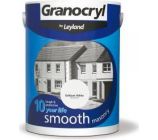
Masonry Paint
-

Leyland 5lt Granocryl Masonry Paint
From:£22.49(inc VAT)multiple sizes -

Leyland 2.5lt Granocryl Masonry Paint
From:£12.95(inc VAT)multiple sizes -

Sandtex Trade High Cover Smooth
From:£24.95(inc VAT)1 colour multiple sizes -

Johnstone's Stormshield Smooth Masonry Paint
From:£25.49(inc VAT)10 colours multiple sizes -

Leyland 10lt Granocryl Masonry Paint
From:£40.49(inc VAT)multiple sizes -

Johnstone's Self-Cleaning Masonry Paint
From:£105.95(inc VAT)multiple sizes
What is masonry paint?
Masonry paint is acrylic-based paint that has been formulated for the outside of buildings. They are designed to easily adhere to coarse and difficult surfaces, such as brick and exterior surfaces. Masonry paint is ideal for providing an extra layer of protection against the effects of weather and dirt.
Textured or smooth masonry paint?
Textured masonry paint helps cover cracks and uneven surfaces whilst smooth masonry paint is ideal for covering large surface areas as it is easier to apply. When choosing which masonry paint to go for, consider the type of wall you are painting:
For walls and surfaces with blemishes, cracks or uneven texture, go for textured masonry paint
For larger surface areas, brickwork and pebbledash walls, opt for smooth masonry paint.
If in doubt, do not hesitate to contact us where we will be happy to advise you on the best option for your project.
How long does masonry paint take to dry?
When applying masonry paint to exterior surfaces, it is important to try and schedule painting when the weather is sufficiently mild enough to dry the paint. All of our masonry paints have individual datasheets which will outline their drying times and temperatures. For reference, Johnstone’s Smooth Masonry is:
Touch dry in 1 hour
Rain resistant after 20 minutes at 23°c
Recoatable after 2-4 hours
How to apply masonry paint
Applying masonry paint is not entirely different from application for other types of paint. Follow the below steps for the recommended process:
- Clean your surface of any residual paint or debris. We stock plenty of surface cleaners that have been specially designed for use prior to painting to prevent fungal or mould growth.
- Apply primer to your surface. This will provide a protective coat and act as an extra binding agent for your masonry paint. All of our masonry paints have datasheets with the recommended primers.
- Once your primer has dried, it is now time to apply your masonry paint. If you are painting the exterior of a home, use a brush for detailed precision around the windows, trim and cutting-in between the walls and the floor.
- Use a paint roller for the remainder of the painting and check your masonry paint’s datasheet for the recommended size nap.
- Apply several thin coats of paint to create a harder surface compared to applying in one thick coat.
- Use your product’s datasheet to find out your masonry paint’s specific drying time and allow sufficient time to cure






